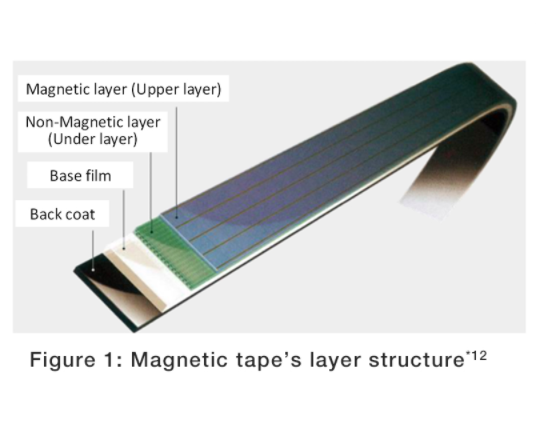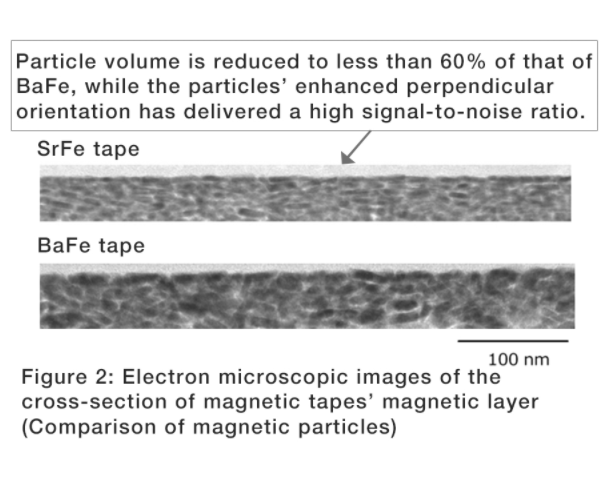Enhancement of storage is made in magnetic tapes using strontium ferrite (SrFe) magnetic particles
Bengaluru, NFAPost: FUJIFILM Corporation (President: Kenji Sukeno) announced that it has achieved the world’s record 317 Gbpsi recording density with magnetic tapes using a new magnetic particle called Strontium Ferrite (SrFe)4.
The record was achieved in the tape running test, conducted jointly with IBM Research. This represents the development of epoch-making technology that can produce data cartridges with a capacity of 580TB (terabytes), approximately 50 times greater than the capacity of current cartridges. The capacity of 580TB is enough to store data equivalent to 120,000 DVDs.
SrFe is a magnetic material that has very high magnetic properties and is stable to maintain high performance even when processed into fine particles. It is widely used as a raw material for producing magnets for motors. Fujifilm has applied its proprietary technology to successfully develop ultra-fine SrFe magnetic particles, which can be used as a magnetic material for producing particulate magnetic tape media for data storage.

The company has been conducting R&D for commercial use of SrFe magnetic particles as potential replacement of Barium Ferrite (BaFe) magnetic particles, currently used in magnetic tape data storage media. Magnetic tapes used in this test have been produced at the company’s existing coating facility, confirming the ability to support mass production and commercialization.
The amount of data in the society is exponentially increasing due to the introduction of high-definition 4K / 8K video, advancement in IoT / ICT, and the proliferation of Big Data analysis. “Cold Data,” or data that was generated a long time ago and rarely accessed, is said to account for over 80% of all data available today.
There is a fast-growing trend of utilizing such Cold Data and other accumulated data, creating the need to secure safe, affordable and long-term data storage. Magnetic tapes have been used by major data centers and research organizations for many years as they not only offer benefits including large storage capacity, low cost and long-term storage performance, but also create air gap data protection, physically isolated from the network, thereby minimizing the risk of data damage or loss caused by cyberattacks.

In the future, magnetic tapes are expected to be used in cutting edge research fields involving large-scale data generation, such as the use of hybrid cloud environment*6for efficiently managing massive data, smart-manufacturing for high-quality and high-efficiency production, and connected vehicles with internet connectivity.
Fujifilm has evolved its unique magnetic tape technology “NANO CUBIC”*7 to further increase the tapes’ data recording density. The company’s unique technology to synthesize nano-sized particles is applied to control particle growth by adjusting the addition of trace elements and the conditions for blending raw materials.
This way, the particle volume is reduced to less than 60% of that of the current BeFe magnetic particles to successfully produce ultra-fine SrFe magnetic particles suitable for coating on magnetic tapes. A new dispersant is then used to evenly disperse and arrange the ultra-fine SrFe magnetic particles in the order of nanometers so as to achieve a high signal-to-noise ratio.
Additionally, the use of a newly-developed smooth non-magnetic layer (under layer) has improved the smoothness of the tape surface even further, reducing the space between a magnetic head and a magnetic layer for enhanced read back output.
When combined with IBM Research’s new track-follow technology*8, signal processing technology*9and recording/read back devices that support them, the magnetic tape with a servo pattern*10 precisely laid out with proprietary technology can deliver the world’s record 317 Gbpsi recording density, giving a further boost to the potential capacity of magnetic tapes.
As the world’s top*11 manufacturer of magnetic tapes for computer data storage, Fujifilm will continue to develop and supply high-performance and high-quality media and services that satisfy customer needs and expectations to solve social issues.
Fujifilm’s technologies that have contributed to the latest achievement
1) Development of fine SrFe magnetic particles
・ Fujifilm has successfully developed SrFe magnetic particles, which have higher magnetic characteristics and particle volume less than 60% compared to BaFe particles used in current magnetic tape media (Figure 2). They demonstrate excellent recording/read back performance with low noise.
・ Similarly to BaFe, SrFe is a chemically stable oxide, suggesting expectations of excellent performance in long-term data storage.
2) Enhanced perpendicular orientation of SrFe magnetic particles
Fine particles typically create difficulty in achieving their even dispersion. Fujifilm has applied a new dispersant and unique process technology to establish precise particle dispersion, thereby drawing out the performance of fine SrFe magnetic particles to the maximum. Evenly-dispersed SrFe magnetic particles are then arranged perpendicular to achieve a high signal-to-noise ratio.
3) Improved smoothness of magnetic tape surface
The use of a newly-developed smooth non-magnetic layer (under layer) has reduced unevenness in the interface between the magnetic layer and the non-magnetic layer, improving the smoothness of the tape surface. This allows a magnetic head to go closer to the tape surface when reading signals, recorded in the magnetic layer (low spacing), boosting signal detection accuracy and read back performance.
4) Development of high-precision servo writing technology
Fujifilm has developed a unique tape-handling technology to control tape vibrations when writing servo patterns. Fluctuation of servo signals is minimized to maximize drive tracking performance, as assessed by IBM Research, thereby achieving high-density data recording in the direction of tape width.




